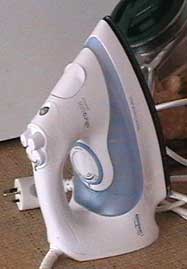Ironing
|
|
Ironing or smoothing is the work of using a heated tool to remove wrinkles from washed clothes. The common tools for this purpose are called "irons", though modern designs are no longer made of iron.
Ironing works by loosening the bonds between the long-chain polymer molecules in the fibres of the material. While the molecules are hot, the fibres are straightened by the weight of the iron, and they hold their new shape as they cool. Some fabrics, such as cotton, require the addition of water to loosen the intermolecular bonds. Many modern fabrics (developed in or after the mid-twentieth century) are advertised as needing little or no ironing.
| Contents |
History
Metal pans filled with charcoal were used for smoothing fabrics in China in the 1st century BC. From the 17th century, sadirons, thick slabs of cast iron, delta-shaped and with a handle, heated in a fire, began to be used in Europe. A later design consisted of an iron box which could be filled with hot coals, which had to be periodically aerated by attaching a bellows. This type was on sale in the USA until at least 1902.
Antique-iron.jpg
In the industrialized world, these designs have been superseded by the electric iron, which uses resistive heating from an electric current. The hot plate, called the sole plate, is no longer made of iron but of aluminium, which is lighter. The heating element is controlled by a thermostat which switches the current on and off to maintain the selected temperature.
The invention of the resistively heated electric iron is credited to Henry W. Seeley of New York in 1882. In the same year an iron heated by a carbon arc was introduced in France, but was too dangerous to be successful. The first thermostatically controlled electric iron appeared in the 1920s.
In recent years, a Leicester rock climber invented the sport of Extreme Ironing, which consists of ironing clothing under creatively difficult circumstances.
Modern Irons
Modern irons available for sale to consumers have some or all of the following features (more expensive models have more features, as one would expect):
- Ejection of steam through the clothing during the ironing process;
- A water reservoir inside the iron (used for the steam generation);
- An indicator showing the amount of water left in the reservoir;
- A thermostat ensuring maintenance of a constant temperature;
- Convenient method for setting the iron down, usually on its end / vertically, so as to not allow contact between the hot part and either table or clothes;
- A temperature control dial showing a range of possible temperatures (typically marked with types of cloth instead of absolute degree measurements, for example, "wool", "cotton", "linen", etc.);
- Constant steam feature - constantly sends steam through the hot part of the iron into the clothes;
- Cord control - the point at which the cord attaches to the iron has a spring to hold the cord out of the way while ironing and likewise when setting down the iron (prevents fires, is more convenient, etc.).
- Steam burst feature - sends a burst of steam through the clothes when the user presses a button;
- (advanced feature) Dial controlling the amount of steam to emit as a constant stream;
- (advanced feature) Anti-burn control - if the iron is left flat (hot part touching clothes) for too long, the iron shuts off to prevent fires;
- (advanced feature) Anti-energy-waster control - if the iron is left undisturbed for several (10 or 15) minutes, the iron shuts off to save energy and prevent fires.
- Cordless irons - the iron is placed on a stand for a short period to warm up, using thermal mass to stay hot for a short period. These are useful for light loads only.
Have just appeared automatic ironing robots, like Siemens AG Dressman (see link below).
Usage Notes
- Irons are commonly available as a consumer good.
- Prices range from US$18 to above US$115, depending on features (above).
- Most ironing is done on an Ironing board, a small, portable, foldable table with a heat resistant top.
- Permanent press clothing was developed to reduce the ironing necessary by combining wrinkle-resistant polyester with cotton.
- Commercial laundries typically use steam presses to iron clothes instead of irons;
- Clothes that are typically ironed include shirts, pants (trousers), and skirts.
- Clothes that are typically NOT ironed include underwear, socks, sheets, sweaters, and materials where wrinkling is not a factor;
- Irons cause many fires and injuries each year due to their being very heavy, very hot, and often used on ironing boards that can fall over onto small children;
- Irons used to be very much more dangerous due to the electrical cords fraying; modern insulation is much safer and better able to cope with being heated.
Safe ironing temperatures
- Linen: 230 °C
- Triacetate: 200 °C
- Cotton: 204 °C
- Viscose: 190 °C
- Wool: 148 °C
- Polyester: 148 °C
- Silk: 148 °C
- Acetate: 143 °C
- Acrylic: 135 °C
- Lycra/Spandex: 135 °C
- Nylon 6.6: 135 °C
Ergonomy
Continuous manual ironing can be a cause of repetitive strain injury to the user's wrist.
See also
External links
- Official website about Siemens / Bosch Dressman Shirt Ironing Robot (http://www.siemensappliances.co.uk/site%2FDressmanshirtiron_434.asp) and a review (http://www.futurepundit.com/archives/cat_robots.html); the product already is in shops (http://www.keukenlust.com/product_info.php?products_id=279).
fr:repassage
de:BŁgeleisen es:planchado it:Ferro da stiro nl:Strijkijzer ja:アイロン

